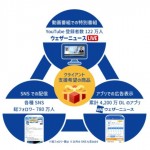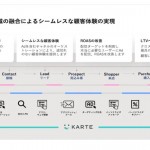YieldMetricsは、デジタル広告のデイジーチェーンに透明性をもたらす
 YieldMetrics is trying to bring new granularity to an established category: online advertising competitive intelligence. The company’s crawler‑based technology works by loading a publisher page and tracking everything that happens with the ads there, surfacing data such as percentage of ads direct-sold versus programmatically traded, ad networks used, exchanges/SSPs used, and so on. Target customers include all ecosystem players, including advertisers, agencies, publishers, and ad networks.
YieldMetrics is trying to bring new granularity to an established category: online advertising competitive intelligence. The company’s crawler‑based technology works by loading a publisher page and tracking everything that happens with the ads there, surfacing data such as percentage of ads direct-sold versus programmatically traded, ad networks used, exchanges/SSPs used, and so on. Target customers include all ecosystem players, including advertisers, agencies, publishers, and ad networks.
Co-founder Gabe Gottlieb plans to use a new $1.7 million seed round to further develop and market the company’s AdRoutes product.
Gottlieb spoke with AdExchanger.
AdExchanger: What problem do you solve?
GABE GOTTLIEB: We solve what we call transparency in the advertising space. We think there’s not enough clarity around how people are actually buying and selling ads. From the publisher standpoint, how their departments are selling their ads, and then from the advertiser standpoint, how an advertiser’s own campaign is being fulfilled and commissioned on a competitive landscape. Also, how are ad networks sourcing inventory on exchanges, the arbitrage that’s going on out there, etc.
Yeah, absolutely. I think competitive market intelligence, too, because we provide information on how, if you work with an ad network, how they’re sourcing that inventory. Or if you’re a publisher and you’re working with an exchange, how they’re selling inventory, things like that.
What are your observations about how marketing competitive intelligence have changed as a result of programmatic media? And, how do you play in the RTB world?
We see it getting more complicated and more obfuscated with a lot of arbitrage out there. An exchange will send an impression to a network, which will throw it back to a different exchange, so basically a lot of complication. That oftentimes is a disservice to people at the end of the chain, the publisher and/or the advertiser. The advertiser is getting some impressions. Three different parties maybe are taking mark‑ups on that impression that they could have just bought through a more efficient means.
Or for a publisher, maybe they’re not getting the full value of their inventories. We’re seeing, when we talk to publishers and advertisers, they’re really interested in this kind of thing, how an advertising site might be monetized. Also, the plethora of choices now in that non‑reserved space — how can I set my monetization on this?
Who is your target customer?
We sell to everyone in the space. We sell to publishers. We’ve had really good success with ad networks and ad tech providers, and then advertisers and agencies as well.
What’s the revenue model?
It’s a subscription model. We just do a deal with the ad network and the whole team gets access, all the sales people, ad‑ops people, strategy people. Everyone gets a seat.
Who are you most directly competitive with?
People compare us to ComScore, Nielsen, or some of the more affiliate‑based people like MixRank and WhatRunsWhere. What we think makes us unique is a really deep intelligence around how the impressions are actually being delivered in the market today.
And how does that work?
It’s a crawler‑based technology. We load a publisher page and basically keep track of everything that happens within the page, all the HTML, JavaScript, CSS, ad calls, redirects, creative, etc. When downloading a page, we basically build a cause‑and‑effect relationship and can see all these business relationships. We build a tree of how everything got served.
Right now we crawl the top 3,000 publishers in the U.S. and the top 800 in the UK. We gather these data around who’s advertising, how they’re buying, where these ad networks are sourcing inventory, how much is bought direct and indirect. Then basically, we analyze that data and update our analytics dashboard.
Our customers log in and they have a view into that data. As I said, our goal is to make it really actionable, really easy to interpret, really simple for people to understand, so they’ve got the different breakdowns. They can look at a publisher. They can look at an advertiser, an ad network, and dive in and see basically everything we know about it.
Is there a big challenge around data visualization?
Absolutely. We’ve got a huge data warehouse with tons of data for every day, and all the different networks and exchanges and sites. Our main challenge is how to deliver that to the user in a way that they can take business action on, and not have to be an analyst or statistician or engineer. Our continual goal is always to simplify our data and make it easier to interpret.
Our very first version, the data was all one big chart. Maybe it was 100 rows. Now, it has evolved significantly — it’s just a little graph that shows how the publisher is selling, what percent direct, what percent exchange, network, etc. Then there’s a list from that.
It’s much easier for someone who’s not a data‑head to hop in and understand exactly what’s happening.
How did the early version of the product get built?
I worked at Microsoft on Windows. We built some technology and I talked to people, changed it, and added more features, pivoted it a bit. It wasn’t like I woke up one morning and said, “I’m going to build a competitive market intelligence company.”
Do you have plans for the data you gather outside of making it available to customers via subscription? For instance, research purposes? Or?
We think a lot of instant research applications, yeah. I think the raw data set is really interesting and what we’ve built on top of it is what we look at when we look at that data. For example, we have tons of information about creative, which ones succeed and which ones fail. Yeah, I think there could be some really interesting uses around that, around learning about creative optimization, for example.
Whether we do that at the company or we license the data to someone else so they can integrate it for SSP, or exchange [remains to be seen].
Any observations on Facebook? It would seem to be obviously out of reach of the platform.
Yeah, unfortunately, we don’t crawl it today. We don’t really have any plans to in the immediate term, I would say. It’s certainly something we could ask about, certainly something people are really interested in. Yeah, we do see things like tracking pixels and those calls off of site. You can see things like that happening, but nothing inside the products themselves.











